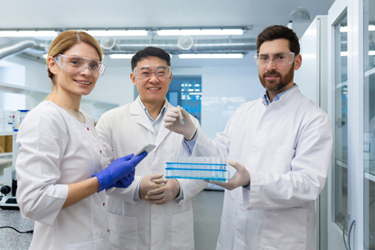Bioprocessing Technology: You Are The Standard

By Matthew Pillar, Editor, Bioprocess Online

Paul Priebe, an independent bioprocessing consultant, has been in the business of engineering biologics manufacturing solutions for nearly four decades, a couple of them with industry heavyweights Pall Corporation and Sartorius Stedim Biotech. More importantly, he’s spent the bulk of those years plugged into the organizations setting the course for bioprocessing equipment standards, and not just in a figurehead kind of way. He spent 12 years on the board of the Bioprocess Systems Alliance (BPSA) and still serves on its Scientific Advisory Council. He’s a Bioprocessing Equipment Subcommittee member and contributing author at the ASME (The American Society of Mechanical Engineers). In a move that might be seen as brazen at the time given his ties to the single-use supply side of the business, he led an initiative to create a single-use systems complaint rate data exchange – giving users the ability to air their grievances in an effort to improve single-use reliability. He was a lead author of the Parenteral Drug Association (PDA) Technical Report 66, a 150-page guide to the application of single-use systems in pharmaceutical manufacturing that served as an early standard where none previously existed. He also demonstrates his passion for sharing his unique skill sets as a regular instructor at Thomas Jefferson University's Jefferson Institute for Bioprocessing.

When Single-Use Makes Sense (And Saves Lots Of Cents)
In the early days of single-use, well, usage, Priebe says bench-level convenience was the motivating factor. If outsourcing the fabrication of a piece of stainless steel equipment was going to slow down the troops, they improvised with plastic. It wasn’t long before rumors of the efficiencies single-use enabled made their way to the C-suite, driving what Priebe refers to as a metamorphosis from a bench-level decision to a C-level directive. “My friend Morten Munk [director, Global Alliance Management at FUJIFILM Diosynth Biotechnologies] showed me a slide, it’s got to be more than 10 years ago, that demonstrated the ability to delay a decision to build a facility, which single use really enables,” says Priebe. “You could build a single-use facility in as little as a year, where a multi-use facility would take in the neighborhood of five years.” In clinical years, the advantage of manufacturing in 12(ish) months versus producing supply in 60(ish) months is a no-brainer.
Be that as it may, manufacturing scale is among the chief considerations biopharma companies have traditionally mulled over when debating single-use versus multi-use. Not long ago, where manufacturing called for a mighty scale, 2,000-liter single-use bioreactor limitations were often ruled out as a non-starter. The unprecedented scale-up needs brought on by the pandemic have changed that calculus. Today, Priebe says 7,000-liter single-use systems are not unheard of, and 5,000-liter systems are daily and common.
Those high-volume bioreactors are now supported by single-use components that cover virtually all unit operations, which is another important consideration that wasn’t even on the table 20 years ago. Back then, even if a single-use bioreactor met your production scale requirements, it might have been scuttled due to the complexity of building and maintaining hybrid systems.
These more recent developments are why Priebe says, “if you can go single-use, you will go single-use.”
Does Single-Use Introduce Supply Chain Risk?
Speaking of the COVID pandemic, when asked what’s keeping them from deploying more single-use technology, nearly 14 percent of the audience during our recent Bioprocess Online Live event on single-use systems answered “because supply chain issues are scary.” During the pandemic, supply constraints in virtually every bioprocessing unit operation rattled the industry. Those aftershocks remain. Priebe says dual sourcing has been a go-to risk mitigation tactic, and that it’s been a driver of the increased focus on single-use standardization. “”The terms dual sourcing and assurance of supply have been used synonymously or interchangeably. In the case where true dual sourcing is not an option because of a lack of standardization of technology, there are other ways to achieve assurance of supply,” he says. “Dual sourcing may or may not de-risk your assurance of supply because at some point there may be a single source item, back in N minus one or N minus two in the supply chain, and you think by buying from two separate suppliers that you've eliminated a risk. In the end, it's just one layer behind the curtain, and it's not an effective risk mitigation activity,” he says.
Priebe pulls no punches when he shares the poorly-kept secret to achieving single-use supply security: well-place money. “It takes a fair amount of work and investment on the buying side of the equation to understand supply chain risks and build appropriate risk mitigation strategies.” While stockpiling inventory seems obvious, it’s not all about safety stock and volume, he says, but an intelligent assessment of the risks you face. An elevated risk of natural disaster, or instance, might warrant sourcing from a supplier (or suppliers) with geographically disparate manufacturing facilities. “There are certainly third-party providers that look at supply chain risk. I don't know that they did a very good job for the industry during the pandemic, but the pandemic was pretty unprecedented, and some of the best run industries in the world fell on their face due to small changes in buying behaviors of their customers,” he says.
Simplicity is another supply risk mitigation strategy Priebe is quick to suggest. He cites a study published by BioMarin that assessed single-use assembly and configuration at the point of use. “They took literally dozens and dozens of different designs down to a handful. In terms of managing supplies in-house, by using genderless connections, they were able to very significantly reduce the total number of SKUs they were using to support their processes.” A simplified supply chain is an easier-managed and more accurately forecasted supply chain, which not only mitigates the risk of supply shortage, but also creates a commercial and cost-savings advantage.
Single-Use Standards Hit Their Stride
The USP (United States Pharmacopeia) standard 665 [Plastic Components and Systems Used to Manufacture Pharmaceutical Drug Products and Biopharmaceutical Drug Substances and Products] will take effect May 1, 2026. Priebe says its enactment will burden the supply base with a requirement to provide some additional extractables data, but he doesn’t foresee any major disruption given that the USP standards are already a de-facto standard of GMP (Good Manufacturing Practice).
Where Priebe is calling for disruption is involvement among stakeholders, users and suppliers alike, to get skin in the standards game. He points to Jeff Carter, upstream applications leader at Cytiva, as a case in point. Earlier this month, Carter, who chairs the ASTM (American Society for Testing and Materials) E55.07 Single-Use Standardization Working Group, held a workshop in Philadelphia to roadmap the organization’s standards writing activities for single-use systems in pharmaceutical and biopharmaceutical manufacturing applications. “There's been a lot of work done to get to a foundation of standards around particulates,” says Priebe. “One of the things that I've been railing against—and anybody who knows me has probably got me started on this at one point—is that everyone says we need a standard, but what’s appropriate to standardize?” In the case of particulates, Priebe laments that we didn't even have a vocabulary standardized. “USP 788, Particulate Matter in Injections, for instance, is used as a qualification exercise for single-use systems, but it's not really meaningful. It's written for drug product, and it's written for subvisible particles. It's not written for dry systems, and it's not written for the key risk of single-use systems, which are visible particulates.” Given that there’s no other existing standard on the matter, Priebe says we must first standardize on how particles are captures from a single-use system in order to count them, how those particles are characterized, and how they’re reported on. He points to the work being done to that end by Klaus Wormuth, Ph.D., principal scientist at Sartorius, as another example of industry taking the reins. “Klaus has built a plan around the foundational standards that need to exist, and then you build on top of that.”
Priebe admits it’s not easy. “These are complex topics, and sometimes suppliers may feel excluded by a standardization activity. And of course that's not the intent. These are consensus standards. And if someone leverages a consensus standard in the qualification of their single-use system, they do not have to defend that choice against a regulatory body because the consensus-driven standards have people from EMA and FDA sitting on the standards writing committees. They have a voice, and they're required to respect these consensus-driven standards.
Much Single-Use Standardization Work Remains
There is, as Priebe puts it, a “ton” of work yet to be done. He invites those interested to reach out to him or Cytiva’s Jeff Carter to talk more about it. “I've participated in quite a bit of standards writing activities over the past 20 years or so. I have found it to be both personally and professionally rewarding. If you ever find yourself saying, “they ought to write a standard,” go in the bathroom and look in the mirror and say “they is you.” If you want a standard, then show up and participate, because it doesn't come from somewhere else. It only comes from the participants in the industry.”
